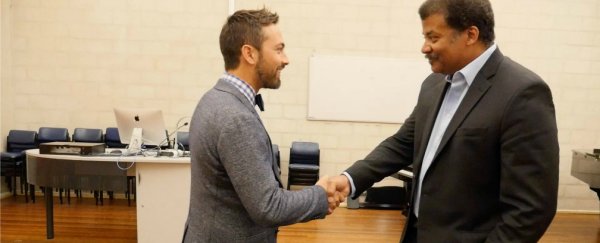Most of us are familiar with the concept of six degrees of separation - the idea is that anyone in the planet can be connected to anyone else in just six steps. So through just five other people, you're effectively connected to the Queen of England, Tom Cruise, or even a Mongolian sheep herder. But is there actually any science to back up this commonly cited theory? Derek Muller investigates in the latest episode of Veritasium.
If you just take a look at the numbers, the six degrees of separation idea seems pretty plausible. Assuming everyone knows at least 44 people, and that each of those people knows an entirely new 44 people, and so on, the maths shows that in just six steps everyone could be connected to 44^6, or 7.26 billion people - more than are alive on Earth today.
But is there any experimental evidence to show that's the case in IRL social groups? As Derek explains, the whole basis of the theory came from a 1929 short story called Chains, in which one of the characters challenges the others to find another person on Earth that he can not connect himself to through fewer than five intermediaries.
This idea wasn't scientifically tested until the 1960s, when a psychologist sent 300 packages out to people in Nebraska and Boston, and asked them to use their networks to get them back to one specific target - a stockbroker living in Boston. They weren't asked to forward it to him directly, but to send it to someone they knew on a first name basis, with instructions for that person to forward it on to someone in their network that they thought might know the stockbroker.
Only 64 of those packages actually reached the target, with an average path length of just 5.2 intermediary connections, and this experiment was used as evidence for six degrees of separation, or the 'small world phenomenon', as the researcher called it.
But Derek dug a little deeper and found that, of the original 300 packages, 100 were sent to people already living in Boston (where the target also lives) and 100 were sent to stockbrokers who shared a profession with the target, so there were really only 100 purely random packages sent out. And of those 100, only 18 made it back to the target. "So we're talking about a sample size of 18 is all the evidence there was for six degrees of separation," Derek explains.
But that doesn't mean it doesn't exist. The real breakthrough came a few decades later thanks to a college game called 'Six Degrees of Kevin Bacon', where students had to try and link any actor to Kevin Bacon via their co-stars in six steps or less (usually after smoking a whole lot of weed, we can only assume).
The huge volumes of data collected by the game allowed sociology researchers to analyse exactly how interconnected Hollywood actors really are, and they found that six degrees of separation does indeed appear to exist, but it's people's random acquaintances, not their friends, that are the key to all of this.
In fact, as Derek figures out with the help of his new friend Neil deGrasse Tyson, this six degrees is now actually shrinking thanks to our heavily connected lives online. Watch the video above to see him explain how that's happened, and find out how you can help take part in your very own six degrees experiment. If nothing else, take comfort in the fact that no matter how lonely you feel, one of your acquaintances could be the key to putting you in touch with someone who'll change your life, in just six (or less) steps.
